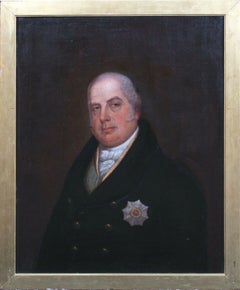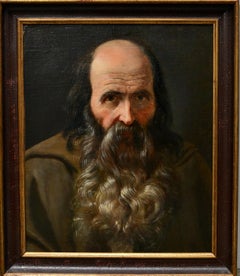James Lonesdale Art
to
1
Overall Width
to
Overall Height
to
1
1
1
1
1
1
1
1
1
1
1
8,225
2,805
2,504
1,655
1
1
Artist: James Lonesdale
Portrait King William IV, s Duke Of Clarence, early 19th Century
By James Lonesdale
Located in Blackwater, GB
Portrait King William IV, s Duke Of Clarence, early 19th Century
by James Lonsdale (1777-1839)
Fine early 19th Century portrait of King William IV as...
Category
19th Century James Lonesdale Art
Materials
Canvas, Oil
Related Items
Nude goddess oil on canvas painting
Located in Barcelona, Barcelona
Tuya Natsagdorj (Mongolia 1970) - Naked Goddess - oil on canvas
Oil measures 63x53 cm.
Frame measures 66x56 cm.
Natsagdorj Tuya is a female artist who graduated from the kyiv School of Theater Arts in Ukraine and the Kyoto School of Art in Japan. Popular painter in the United States and Japan. In 2006 he participated in the exhibition "Mongolian art...
Category
Early 2000s Post-Modern James Lonesdale Art
Materials
Oil, Canvas
Portrait of a Russian Artist or Dignitary
Located in Stockholm, SE
This 19th-century oil on canvas portrait depicts a distinguished male figure—probably Russian and possibly an artist or a dignitary—with a striking resemblance to the renowned Russia...
Category
19th Century James Lonesdale Art
Materials
Canvas, Oil
Catalan peasant oil on canvas painting spanish
By Luis Graner Y Arrufi
Located in Barcelona, Barcelona
Oil mesures 36x23 cm.
Frameless.
Restored.
Category
1930s Modern James Lonesdale Art
Materials
Canvas, Board, Oil
19th century portrait painted in St Petersburg in 1819
Located in London, GB
Signed, inscribed and dated, lower right:
'Geo Dawe RA St Petersburgh 1819', also signed
with initials, lower centre: 'G D RA'; and signed and inscribed verso:
'Geo Dawe RA Pinxit 1819 St Petersburgh';
Also inscribed on the stretcher by Cornelius Varley with varnishing instructions.
Collections:
Private collection, UK, 2010
Literature:
Galina Andreeva Geniuses of War, Weal and Beauty: George Dawe...
Category
19th Century Old Masters James Lonesdale Art
Materials
Oil, Canvas
Woman with headscarf original oil on canvas painting
By Albert Rafols Culleres
Located in Barcelona, Barcelona
Albert Rafols Cullerés (1892-1986) - Woman with scarf - Oil on canvas
Oil measures 46x38 cm.
Frameless.
Catalan painter formed the Llotja with ...
Category
1930s Impressionist James Lonesdale Art
Materials
Canvas, Oil
$1,193
H 18.12 in W 14.97 in
Thoughtful woman on the terrace of the bar oil on canvas painting
Located in Barcelona, Barcelona
Frederic Cabanas (1954) - Pitussi - Oil on canvas
Oil measurements 92x65 cm.
Without frame.
Frederic Cabanas
Multifaceted artist, painter, sculptor, musician, photographer, wr...
Category
1980s Fauvist James Lonesdale Art
Materials
Canvas, Oil
$1,515
H 36.23 in W 25.6 in
“Enfant A La Collarette” The Child in the Collar.
By René Genis
Located in Berlin, MD
Rene Genis (French 1922-2004) “Enfant A La Collarette” The Child in the Collart. Portrait of a disturbing young man with a rather defiant, petulant look in his expression. Dark eye...
Category
Mid-20th Century James Lonesdale Art
Materials
Canvas, Oil, Laid Paper
$2,025 Sale Price
48% Off
H 24 in W 16 in D 1 in
Pensive Woman oil on canvas painting european art
Located in Barcelona, Barcelona
Title: Pensive Woman
Artist: Vicente Oliver (1896–1970)
Technique: Oil on canvas
Dimensions: 18.1 x 15.0 in (46 x 38 cm)
Support: Unframed canvas
Date: Mid-20th century
Signatu...
Category
1930s Modern James Lonesdale Art
Materials
Canvas, Oil
$1,312 Sale Price
26% Off
H 18.12 in W 14.97 in
Girl playing the flute oil painting
Located in Barcelona, Barcelona
Enrique Montserrat Foj (1935-2022) - Girl playing the flute - Oil
Oil on canvas glued to cardboard.
Oil measures 46x38 cm.
Frameless.
Romantic cartoonist, especially for the foreign market, and also a gymnast.
Cartoonist linked to Editorial Bruguera and its agency Creaciones Editoriales. She got her start drawing girls' or adventure comics in Stories and the Sissi Graphic Novel Supplement. Much of her work from the 1960s was aimed at the European market for young women's magazines through the Selecciones Ilustradas agency. Anecdotally, he collaborated with Marvel Comics, drawing a romantic comic based on a script by Stan Lee for the title My Love (later republished in Our Love Story), credited there as Enrique Monserratt.
He retired from comics in the 1980s to focus on painting.
He was also an Olympic gymnast, a member of the Barcelona Gymnastics Center and the Barcino Tennis Club. He was champion of Spain in the third category (1955) and third in the Spanish Artistic Gymnastics Championships (1961). He participated in the Mediterranean Games (1959) and in the Rome Olympic...
Category
1980s Impressionist James Lonesdale Art
Materials
Cardboard, Oil, Canvas
Man portrait oil on canvas painting
By Jordi Curos
Located in Barcelona, Barcelona
Jordi Curós Ventura (1930-2007) - Man portrait
Oil on canvas.
Canvas measurements 46x38 cm.
Frameless.
Jordi Curós Ventura (Olot, Girona, March 4, 1930) is a Spanish painter.
He tr...
Category
1970s Fauvist James Lonesdale Art
Materials
Canvas, Oil
surreal woman face oil on canvas painting
By Miquel Torner de Semir
Located in Barcelona, Barcelona
Miquel Torner de Semir (1938) - Surrealist figure - Oil on canvas
Oil measures 46x38 cm.
Frameless.
Miquel Torner de Semir (1938)
Catalan painter attracted by the Middle Ages and I...
Category
1990s Surrealist James Lonesdale Art
Materials
Canvas, Oil
Contemporary Figurative Oil Painting, Dreamers II
Located in Vilnius, LT
Serenity, warmth, and harmony are at the heart of Dreamer, a captivating oil on canvas painting that invites reflection and a sense of peace. The work portrays a figure with closed e...
Category
2010s Contemporary James Lonesdale Art
Materials
Canvas, Oil, Cotton Canvas
James Lonesdale art for sale on 1stDibs.
Find a wide variety of authentic James Lonesdale art available for sale on 1stDibs. You can also browse by medium to find art by James Lonesdale in canvas, fabric, oil paint and more. Not every interior allows for large James Lonesdale art, so small editions measuring 70 inches across are available. Customers who are interested in this artist might also find the work of Fiona Morley, Jay-C, and John Emms. James Lonesdale art prices can differ depending upon medium, time period and other attributes. On 1stDibs, the price for these items starts at $5,591 and tops out at $5,591, while the average work can sell for $5,591.

